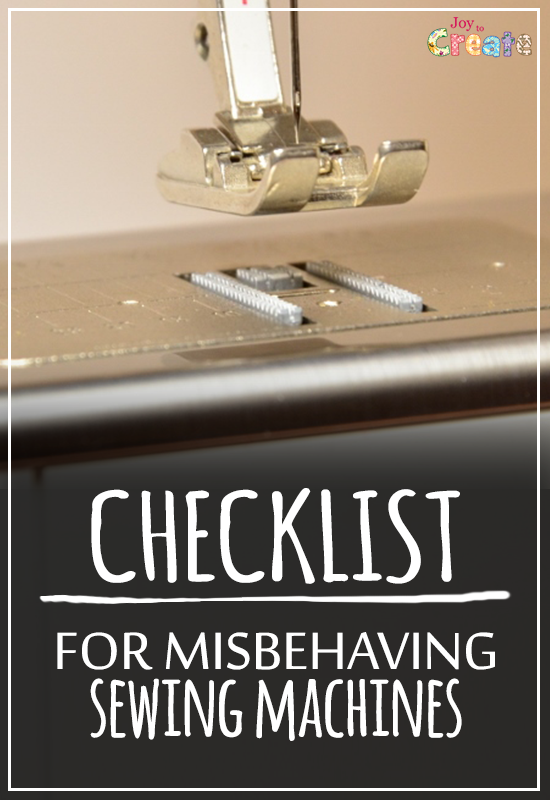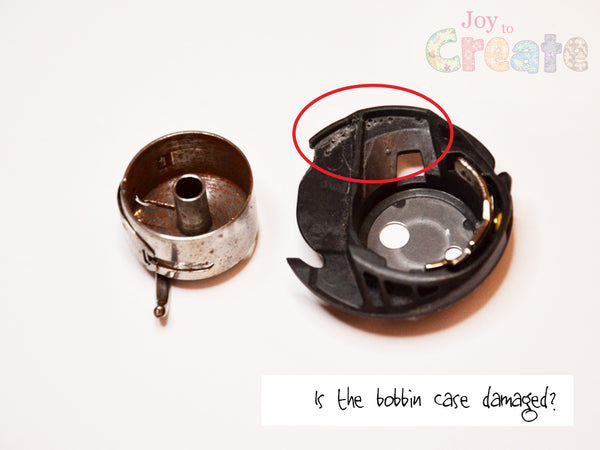Checklist - For misbehaving sewing machines!

Read our most popular solutions to your most popular problems...
Noises: clunking, grinding, scratching..
Stop sewing and switch your machine off to investigate.
Is your needle bent?
The hook passes the needle with a clearance of around 0.1mm or less so if the needle is bent it could strike the hook or bobbin case. This will often break the needle and cause secondary damage or at the very least will not form a stitch. Replace the needle immediately and dispose of the bent one.
Is the bobbin case damaged?
As mentioned above, bent needles can be very destructive. Remove the bobbin and bobbin case from your machine and have a good look at the area where your bobbin sits. Top loading bobbins use mainly a self lubricating plastic bobbin case and if a bent needle hits it, it will punch a hole, causing thread snagging. If your bobbin case has holes in it from the needle, has rough edges or rust on a metal bobbin then smoothe thread passage is compromised and it will need replacing.

Thread is knotting beneath my fabric
Threaded up correctly?
It seems obvious but this is definitely number one in our hit list for common problems. You may think you have threaded up correctly but it is the first thing you need to check in this situation. Take the top thread off the machine and thread it up again, being sure to follow any directions displayed on the machine. I prefer to start with the presser foot up to release the top tension unit as I guide the thread through the machine, following the thread path. Ensure your thread is snapped into the take up lever and slotted into all of the guides that lead down to the needle. At this point I then lower the presser foot to apply tension and then thread the needle.
Is the tension working?
Once you have re-threaded your machine you can check the tension by raising the presser foot, pulling the thread through the needle and to the left, where you should feel very little resistance. Now lower the presser foot and tug on it again gently. You should feel a resistance and see the needle bending slightly. This indicates the top tension is working.
Is it the bobbin?
Check the bobbin is threaded correctly by taking it out and placing it back in, ensuring it is in the right way around. We have all put it back in the wrong way at some point! If you are still unsure then check you are doing it correctly by looking in your manual.
Are your feed dogs down?
When the feed dogs (the two rows of metal teeth protruding above the needle plate) are down on your machine, the fabric won't move and your machine will sew on the spot until the thread collects beneath the needle plate and forms a “birds nest”. Turn your machine off, lift the presser foot and clear any thread debris. Rotate the handwheel and check that the feed dogs are coming up higher than the needle plate, enabling them to drive the fabric. If they aren’t then you will need to re-engage them. You can do this on most machines by operating a lever (refer to your manual if you can’t find it) then rotating the hand wheel until they re-engage.
Unattractive stitches, malformed, snagging
Have you got the correct foot on?
While the standard zig zag foot is the most versatile foot there are many presser feet designed for specific purposes. For example a pattern foot will have a groove on the underside to allow for the thicker build up of thread when sewing satin stitch. A straight stitch foot and straight stitch needle plate give the best results when stitching straight lines because the material is better supported and less likely to be pulled down into the feed dogs. Check you have the correct foot on!
Have you selected the right needle and thread combo?
As well as choosing a needle designed for the fabric type being sewn upon, it is important to match the needle size to the thread weight as well. The thread sits in a groove running down the front of the needle, after piercing the fabric the needle starts to travel upwards and the thread is gripped by the fabric and forms a loop. This loop is then picked up by the hook and forms the stitch. If the thread is too loose in the groove (a thread too fine or needle too large) then no loop is formed and therefore no stitch. If the thread is too large for the groove (thread too thick or needle too small) then the fabric tends to lift with the needle instead of forming a loop. Try replacing the needle with a standard size 80-90 needle and rethreading with a medium 40 weight thread and see if problem persists.
Does your bobbin look loose or tangled?
Find a fresh bobbin and reload it, checking the thread is correctly guided around the bobbin winding tensioner (small circular spring loaded part on the top of the machine) Wind the bobbin and check it is tensioned properly (no loops of thread poking out) and that the thread is filling the bobbin evenly. Resist the urge to load new threads on top of existing ones on a bobbin, this will not only cause it to snag but may bend the needle and most likely result in other types of damage to your machine.

Thread keeps snapping
Are you using old or cheap thread?
If it snaps easily in your hands when you tug it then don’t use it. Apart from being time consuming when it snaps over and over, the broken thread can collect inside your machine, particularly in the top tension disks which will affect your thread tension. Old thread may also fall apart over time in your projects. Try buying a brand new thread of good quality like Mettler or Gütermann.
My buttonhole is stitching too short
Is the lever for buttonhole engaged?
The automatic buttonhole feature that is now on many machines relies on a lever being set correctly. The machine will seem to stitch for a short distance and then start the other side, resulting in a very short butttonhole. Make sure you have pulled down the buttonhole lever and engaged it in the buttonhole foot. Check the buttonhole size because once the foot has been set to the size of the button (plus a clearance) the lever will operate a microswitch to set the machine off on the next stage of the one step buttonhole. If you are unsure then refer to your manual.

Thank you for reading our list of the most common ways to troubleshoot your machine, we hope it was helpful!
However, if you haven’t found a solution to your problem we advise you to contact a specialist machine engineer for advice. If you are in Hampshire, UK or near, we offer a very reputable servicing and repairs service, so please don’t hesitate to get in touch!
Thanks again,
Steve
Comments
Lillian Schaeffer
March 14 2016
This is some great information, and I appreciate your point that a bent sewing machine needle could cause secondary damage. My needle was bent, and I didn’t notice it for a while, so it ended up breaking off and damaging another part of my machine. I’ll be sure to watch for that problem in the future to avoid this, but I’ll definitely look into having my unit repaired in the meantime. Thanks for the great post! http://www.creativesewingcentersmn.com
Kate Rose
March 06 2016
That is so helpful – thank you so much
Susan Taylor
March 03 2016
I wish I had this the other day, as I ended up using the ‘swearing and finger pointing’ method. Also we have had enough of Leicestershire and want to come back down. Already looking for somewhere to live. I can do Joy’s workshops. Already spend a lot of time here
Lillian Schaeffer
March 14 2016
This is some great information, and I appreciate your point that a bent sewing machine needle could cause secondary damage. My needle was bent, and I didn’t notice it for a while, so it ended up breaking off and damaging another part of my machine. I’ll be sure to watch for that problem in the future to avoid this, but I’ll definitely look into having my unit repaired in the meantime. Thanks for the great post! http://www.creativesewingcentersmn.com
Kate Rose
March 06 2016
That is so helpful – thank you so much
Susan Taylor
March 03 2016
I wish I had this the other day, as I ended up using the ‘swearing and finger pointing’ method. Also we have had enough of Leicestershire and want to come back down. Already looking for somewhere to live. I can do Joy’s workshops. Already spend a lot of time here



Comments
3 Comments